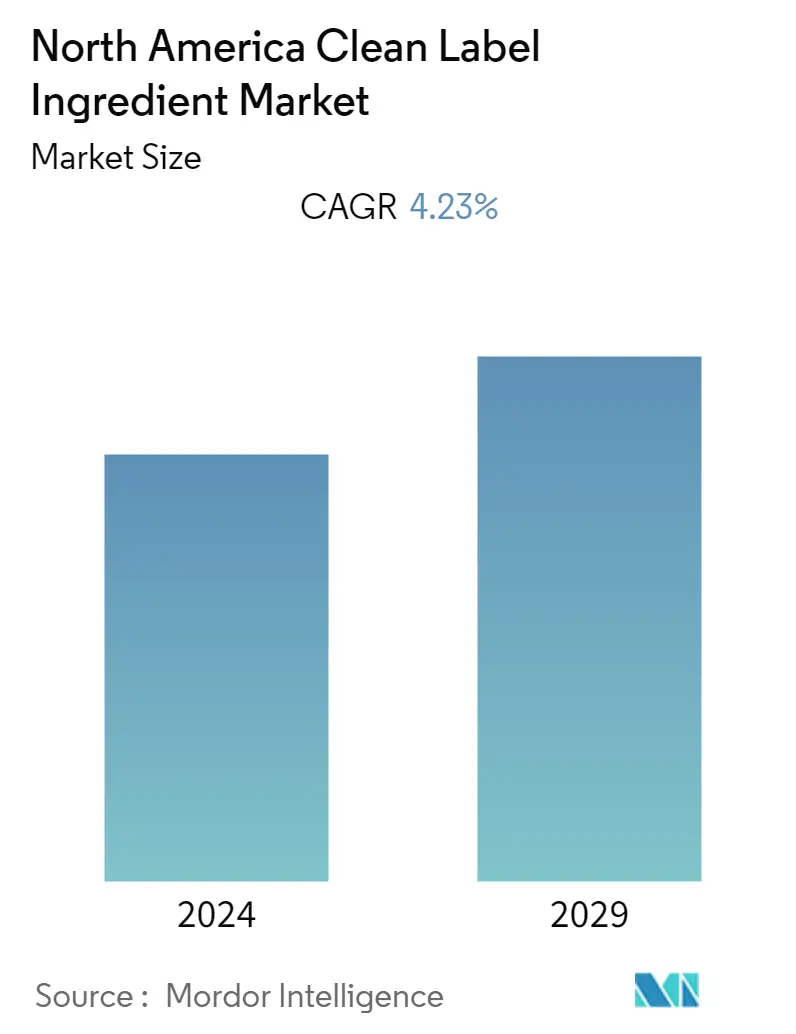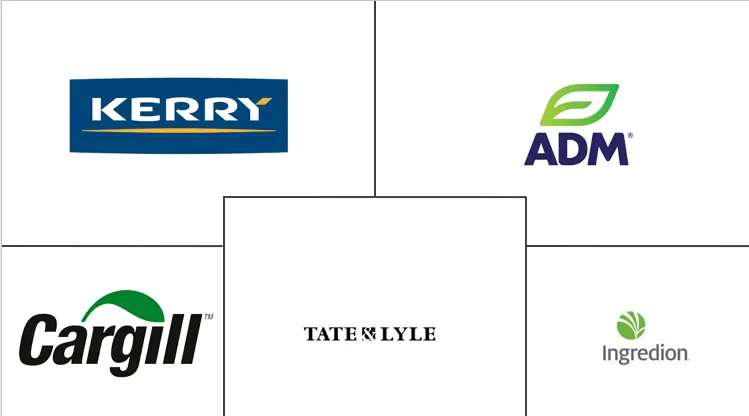Market Size of North America Clean Label Ingredient Industry

| Study Period | 2019 - 2029 |
| Base Year For Estimation | 2023 |
| Forecast Data Period | 2024 - 2029 |
| Historical Data Period | 2019 - 2022 |
| CAGR | 4.23 % |
| Market Concentration | Low |
Major Players
*Disclaimer: Major Players sorted in no particular order |
North America Clean Label Ingredient Market Analysis
North America Clean Label Ingredient Market is projected to grow at a CAGR of 4.23% during the forecast period 2020-2025.
- Consumers demand clean labels on products to gain knowledge about the product that they are about to consume and at what level. Their interest in identifying the ingredients present in the food & beverage products has triggered the growth of the clean-label ingredient market.
- The demand for natural color is growing at a fast rate, due to the adverse health effects of artificial colorants, specifically in dairy and beverage products. The starch segment holds a significant share in the clean-label ingredient market, as more consumer goods companies are beginning to use simpler starches in their products.
North America Clean Label Ingredient Industry Segmentation
The North America clean label ingredients market report includes a study on segmentation by type, which is segmented by color, flavor, starch and sweetener, natural preservative, and other types. Based on the application, the market has been segmented into beverage, bakery and confectionery, sauce and condiment, dairy and frozen dessert, processed food, and other applications. Based on the geography, the regional analysis of the clean labeled ingredients market is also being included in the report.
| By Ingredient Type | |
| Colorants | |
| Flavors and Flavor Enhancers | |
| Food Sweeteners | |
| Preservatives | |
| Others |
| By Application | |
| Beverage | |
| Bakery and Confectionery | |
| Sauce and Condiment | |
| Dairy and Frozen Dessert | |
| Other Processed Foods |
| By Geography | |
| United States | |
| Canada | |
| Mexico | |
| Rest of North America |
North America Clean Label Ingredient Market Size Summary
The North America clean label ingredient market is experiencing significant growth, driven by increasing consumer demand for transparency in food labeling. Consumers are increasingly interested in understanding the ingredients in their food and beverages, which has spurred the demand for clean-label ingredients. This trend is particularly evident in the growing preference for natural colorants, especially in dairy and beverage products, due to concerns over the health effects of artificial additives. The starch segment is also gaining traction as companies shift towards simpler, more natural ingredients. This movement is further supported by heightened awareness of the potential health risks associated with synthetic food additives, such as colorants, flavors, and sweeteners, which have been linked to various health issues. Regulatory bodies like the WHO and FDA have acknowledged these concerns, prompting guidelines that encourage the use of natural additives, thereby bolstering the clean-label ingredient market.
The clean label trend is not only influencing consumer preferences but also driving innovation in product development. In the United States, there is a growing demand for products that are not only clean but also offer enhanced nutritional benefits, such as probiotic cultures and healthier fatty acid compositions. This has led to a surge in new product launches featuring diverse flavors and combinations. Major industry players, including Cargill, ADM, and Kerry, are actively expanding their clean-label ingredient portfolios through strategic acquisitions and product diversification. These companies are leveraging their extensive offerings in proteins, flavors, and colors to strengthen their market position. The clean label movement presents a significant opportunity for food manufacturers to connect with health-conscious consumers and enhance their branding strategies, ensuring continued growth in the North American market.
North America Clean Label Ingredient Market Size - Table of Contents
-
1. MARKET DYNAMICS
-
1.1 Market Drivers
-
1.2 Market Restraints
-
1.3 Porter's Five Forces Analysis
-
1.3.1 Threat of New Entrants
-
1.3.2 Bargaining Power of Buyers/Consumers
-
1.3.3 Bargaining Power of Suppliers
-
1.3.4 Threat of Substitute Products
-
1.3.5 Intensity of Competitive Rivalry
-
-
-
2. MARKET SEGMENTATION
-
2.1 By Ingredient Type
-
2.1.1 Colorants
-
2.1.2 Flavors and Flavor Enhancers
-
2.1.3 Food Sweeteners
-
2.1.4 Preservatives
-
2.1.5 Others
-
-
2.2 By Application
-
2.2.1 Beverage
-
2.2.2 Bakery and Confectionery
-
2.2.3 Sauce and Condiment
-
2.2.4 Dairy and Frozen Dessert
-
2.2.5 Other Processed Foods
-
-
2.3 By Geography
-
2.3.1 United States
-
2.3.2 Canada
-
2.3.3 Mexico
-
2.3.4 Rest of North America
-
-
North America Clean Label Ingredient Market Size FAQs
What is the current North America Clean Label Ingredient Market size?
The North America Clean Label Ingredient Market is projected to register a CAGR of 4.23% during the forecast period (2024-2029)
Who are the key players in North America Clean Label Ingredient Market?
Cargill Inc., Archer Daniels Midland Company, Corbion Inc., Kerry Group PLC and Ingredion Incorporated are the major companies operating in the North America Clean Label Ingredient Market.

